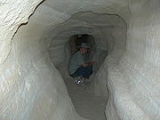
Timna valley
Encyclopedia
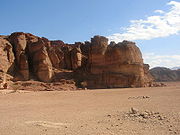
Israel
The State of Israel is a parliamentary republic located in the Middle East, along the eastern shore of the Mediterranean Sea...
in the southwestern Arabah
Arabah
The Arabah , also known as Aravah, is a section of the Great Rift Valley running in a north-south orientation between the southern end of the Sea of Galilee down to the Dead Sea and continuing further south where it ends at the Gulf of Aqaba. It includes most of the border between Israel to the...
, approximately 30 km (18.6 mi) north of the Gulf of Aqaba
Gulf of Aqaba
The Gulf of Aqaba is a large gulf located at the northern tip of the Red Sea. In pre twentieth-century and modern sources it is often named the Gulf of Eilat, as Eilat is its predominant Israeli city ....
and the town of Eilat. The area is rich in copper
Copper
Copper is a chemical element with the symbol Cu and atomic number 29. It is a ductile metal with very high thermal and electrical conductivity. Pure copper is soft and malleable; an exposed surface has a reddish-orange tarnish...
ore
Ore
An ore is a type of rock that contains minerals with important elements including metals. The ores are extracted through mining; these are then refined to extract the valuable element....
, and has been actively mined
Mining
Mining is the extraction of valuable minerals or other geological materials from the earth, from an ore body, vein or seam. The term also includes the removal of soil. Materials recovered by mining include base metals, precious metals, iron, uranium, coal, diamonds, limestone, oil shale, rock...
by humans since the 6th millennium BCE
6th millennium BC
During the 6th millennium BC, agriculture spread from the Balkans to Italy and Eastern Europe, and also from Mesopotamia to Egypt. World population was essentially stable at approximately 5 million, though some speculate up to 7 million.-Events:...
.
Copper Mining
The Egyptians discovered copper ore as early as the 5th millennium BCE, in the NeolithicNeolithic
The Neolithic Age, Era, or Period, or New Stone Age, was a period in the development of human technology, beginning about 9500 BC in some parts of the Middle East, and later in other parts of the world. It is traditionally considered as the last part of the Stone Age...
period, and began the world’s first copper production center in Timna valley. The remains the Egyptians and others left provided for the most extensive example of early mining of any kind in history. During the 14th century BCE, the Egyptians established a trade route through Timna Valley as the surrounding areas heard about the copper-rich area. At the same time the Midianites from the northwestern Arabian Peninsula
Arabian Peninsula
The Arabian Peninsula is a land mass situated north-east of Africa. Also known as Arabia or the Arabian subcontinent, it is the world's largest peninsula and covers 3,237,500 km2...
and local Amalekites began mining alongside the Egyptians. The Egyptian control of the mines declined in the 12th century BCE, but the Midianites stayed. Their advanced culture left thousands of ceremonial artifacts and the Temple of Hathor
Hathor
Hathor , is an Ancient Egyptian goddess who personified the principles of love, beauty, music, motherhood and joy. She was one of the most important and popular deities throughout the history of Ancient Egypt...
, a treasured relic. Mining continued by the Israelite
Israelite
According to the Bible the Israelites were a Hebrew-speaking people of the Ancient Near East who inhabited the Land of Canaan during the monarchic period .The word "Israelite" derives from the Biblical Hebrew ישראל...
s and Nabateans through the Roman period and the 1st and 2nd centuries CE, and then by the Ummayads from the Arabian Peninsula after the Arab conquest (in the 7th century CE) until the copper ore became scarce.
Timna Valley was also home to the beginning of the technological revolution, when people started using metal in daily life. Egyptians used metal chisels and hoes to mine and made tubular shafts with footholds in the walls to move down as far as 30 meters to reach the copper, all revolutionary methods for the time.
Modern history
Scientific attention and public interest was aroused in the 1930s, when Nelson GlueckNelson Glueck
Nelson Glueck was an American rabbi, academic and archaeologist. Dr Glueck served as president of Hebrew Union College from 1947 until his death, and his pioneering work in biblical archaeology resulted in the discovery of 1,500 ancient sites....
attributed the copper mining at Timna to King Solomon (10th century BCE
10th century BC
The 10th century BC started the first day of 1000 BC and ended the last day of 901 BC.- Overview :This period followed the Bronze Age collapse in the Near East, and the century saw the Early Iron Age take hold there. The Greek Dark Ages which had come about in 1200 BC continued. The Neo-Assyrian...
) and named the site "King Solomon's Mines
King Solomon's Mines
King Solomon's Mines is a popular novel by the Victorian adventure writer and fabulist Sir H. Rider Haggard. It tells of a search of an unexplored region of Africa by a group of adventurers led by Allan Quatermain for the missing brother of one of the party...
". Later research has shown that the site was not in use during the 10th century.
In 1959, Professor Beno Rothenberg, director of the Institute for Archeo-Metallurgical Studies at University College, London, led the Arabah Expedition, sponsored by the Eretz Israel Museum
Eretz Israel Museum
The Eretz Israel Museum is a historical and archeological museum in the Ramat Aviv neighborhood of Tel Aviv, Israel.Eretz Israel Museum, established in 1953, has a large display of archaeological, anthropological and historical artifacts organized in a series of exhibition pavilions on its grounds...
, and the Tel Aviv University
Tel Aviv University
Tel Aviv University is a public university located in Ramat Aviv, Tel Aviv, Israel. With nearly 30,000 students, TAU is Israel's largest university.-History:...
Institute of Archaeology. The expedition included a deep excavation of Timna Valley, and by 1990 he discovered 10,000 copper mines and smelting
Smelting
Smelting is a form of extractive metallurgy; its main use is to produce a metal from its ore. This includes iron extraction from iron ore, and copper extraction and other base metals from their ores...
camps with furnaces, rock drawings, geological features, shrines, temples, an Egyptian mining sanctuary, jewelry, and other artifacts never before found anywhere in the world. His excavation and restoration of the area allowed for the reconstruction of Timna Valley’s long and complex history of copper production, from the Late Neolithic
Neolithic
The Neolithic Age, Era, or Period, or New Stone Age, was a period in the development of human technology, beginning about 9500 BC in some parts of the Middle East, and later in other parts of the world. It is traditionally considered as the last part of the Stone Age...
period to the Middle Ages.
The modern state of Israel
Israel
The State of Israel is a parliamentary republic located in the Middle East, along the eastern shore of the Mediterranean Sea...
also began mining copper on the eastern edge of the valley in 1955, but ceased in 1976. The mine was reopened in 1980. For this mine "they adopted the Biblical name Timnah which was the name of an Edomite chief."
Geological Features
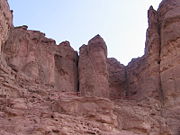
Erosion
Erosion is when materials are removed from the surface and changed into something else. It only works by hydraulic actions and transport of solids in the natural environment, and leads to the deposition of these materials elsewhere...
have created several unique formations that are only found in similar climates.
Solomon's Pillars
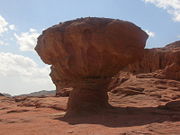
They caused a surge of attention when American archaeologist Nelson Glueck claimed that the pillars were related to King Solomon in the 1930s and gave them the name "Solomon's Pillars". No information has proved this theory, and generally it is not accepted. However, the name stuck, and the claim gave the valley the attention that helped bring about the excavations and current national park.
The pillars are known to be the stunning backdrop for evening concerts and dance performances the park presents in the summer.
Mushroom
The Mushroom is a unique monolithic, mushroom-shaped, red sandstone rock formation. The mushroom shape was caused by wind, humidity, and water erosion over centuries. The Mushroom is surrounded by copper ore smelting sites from between the 14th and 12th centuries BCE.Arches
The Arches were formed by erosion, as well, and can be seen along the western cliff of the valley. Arches are not as rare as Solomon's Pillars and the Mushroom, and similar structures can be found in elsewhere in the world. For example, Arches National ParkArches National Park
Arches National Park is a U.S. National Park in eastern Utah. It is known for preserving over 2000 natural sandstone arches, including the world-famous Delicate Arch, in addition to a variety of unique geological resources and formations....
in Moab, Utah
Moab, Utah
Moab is a city in Grand County, in eastern Utah, in the western United States. The population was 4,779 at the 2000 census. It is the county seat and largest city in Grand County. Moab hosts a large number of tourists every year, mostly visitors to the nearby Arches and Canyonlands National Parks...
, in particular, is famous for its arches. The walking trail that goes to the Arches also goes past the copper mine shafts.
Shrine of Hathor
Beno Rothenberg, the main excavator of the Timna Valley area, excavated a small Egyptian templeEgyptian temple
Egyptian temples were built for the official worship of the gods and commemoration of pharaohs in Ancient Egypt and in regions under Egyptian control. These temples were seen as houses for the gods or kings to whom they were dedicated...
dedicated to Hathor
Hathor
Hathor , is an Ancient Egyptian goddess who personified the principles of love, beauty, music, motherhood and joy. She was one of the most important and popular deities throughout the history of Ancient Egypt...
, the Egyptian goddess of mining, at the base of Solomon's Pillars. It was built during the reign of Pharaoh Seti I
Seti I
Menmaatre Seti I was a Pharaoh of Ancient Egypt , the son of Ramesses I and Queen Sitre, and the father of Ramesses II...
at the end of the 14th century BCE, for the Egyptian miners. The shrine housed an open courtyard with a cella
Cella
A cella or naos , is the inner chamber of a temple in classical architecture, or a shop facing the street in domestic Roman architecture...
, an area cut into the rock to presumably house a statue of the deity. Earthquake damage caused the temple to be rebuilt during the reign of Pharaoh Ramses II in the 13th century BCE, with a larger courtyard and more elaborate walls and floors. The dimensions of the original shrine were 15 by 15 meters, and it was faced with white sandstone that was found only at the mining site, several kilometers away. The hieroglyphics, sculptures, and jewelry found in the temple totaled several thousand artifacts, have provided a lot of important information for archaeologists. A rock carving of Ramses III with Hathor is located at the top of a flight of step carved into the stone next to the shrine.
When the Egyptians left the area in the middle of the 12th century BCE, the Midianites continued using the temple. They erased the evidence of the Egyptian cult, effaced the images of Hathor and the Egyptian hieroglyphics, and built a row of stelae and a bench of offerings on both sides of the entrance. They turned the temple into a tented desert shrine and filled it with Midianite pottery and metal jewelry.
Rock Drawings
There are many rock drawings throughout the valley that were contributed by different ruling empires over time. The Egyptians carved the most famous drawing, Chariots, consisting of Egyptians warriors holding axes and shields while driving ox-drawn chariots. There is a road that leads visitors to the Chariots, located about two miles from the mines in a narrow valley.Archaeologists used the carvings to learn about the rituals and lifestyles of the various cultures that once ruled the area. They also provide information about the plants and animals of the area, in addition to the life and work of the people.
Nature reserve
In 2002, 42000 dunamDunam
A dunam or dönüm, dunum, donum, dynym, dulum was a non-SI unit of land area used in the Ottoman Empire and representing the amount of land that can be plowed in a day; its value varied from 900–2500 m²...
s of the Timna valley were declared a nature reserve, ending all mining activity within the reserve's area. Gazelle
Gazelle
A gazelle is any of many antelope species in the genus Gazella, or formerly considered to belong to it. Six species are included in two genera, Eudorcas and Nanger, which were formerly considered subgenera...
s and ibex still roam the area, but an image of these animals with ostriches found on a high ridge of sand suggests that ostriches once lived here, as well.
Timna Valley Park
Timna Valley Park was opened by the Jewish National FundJewish National Fund
The Jewish National Fund was founded in 1901 to buy and develop land in Ottoman Palestine for Jewish settlement. The JNF is a quasi-governmental, non-profit organisation...
to share Rothenberg’s findings with the public, and there are around 20 different walking trails and some roads in the park to lead visitors to the various attractions. The Jewish National Fund
Jewish National Fund
The Jewish National Fund was founded in 1901 to buy and develop land in Ottoman Palestine for Jewish settlement. The JNF is a quasi-governmental, non-profit organisation...
, a non-profit organization that aids in the development of Israel, funded the creation of many of the non-historic tourist and family attractions and activities in the park.
Replica of the Tabernacle
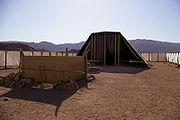
Moses
Moses was, according to the Hebrew Bible and Qur'an, a religious leader, lawgiver and prophet, to whom the authorship of the Torah is traditionally attributed...
to build in order to have a transportable sanctuary during the Exodus
The Exodus
The Exodus is the story of the departure of the Israelites from ancient Egypt described in the Hebrew Bible.Narrowly defined, the term refers only to the departure from Egypt described in the Book of Exodus; more widely, it takes in the subsequent law-givings and wanderings in the wilderness...
from Egypt to the Holy Land
Holy Land
The Holy Land is a term which in Judaism refers to the Kingdom of Israel as defined in the Tanakh. For Jews, the Land's identifiction of being Holy is defined in Judaism by its differentiation from other lands by virtue of the practice of Judaism often possible only in the Land of Israel...
, was constructed in recent years, in the park. It does not use the original metals but is faithful to the biblical description in every other way. The replica includes the laver (a ceremonial basin) and altar in the outer court, complete with the menorah, incense altar and table of twelve loaves of bread for Shabbat
Shabbat
Shabbat is the seventh day of the Jewish week and a day of rest in Judaism. Shabbat is observed from a few minutes before sunset on Friday evening until a few minutes after when one would expect to be able to see three stars in the sky on Saturday night. The exact times, therefore, differ from...
. The only object inside the tabernacle, known as the Holy of Holies, is the ark
Ark of the Covenant
The Ark of the Covenant , also known as the Ark of the Testimony, is a chest described in Book of Exodus as solely containing the Tablets of Stone on which the Ten Commandments were inscribed...
containing the Ten Commandments
Ten Commandments
The Ten Commandments, also known as the Decalogue , are a set of biblical principles relating to ethics and worship, which play a fundamental role in Judaism and most forms of Christianity. They include instructions to worship only God and to keep the Sabbath, and prohibitions against idolatry,...
, the rod of Aaron, and the pot of manna
Manna
Manna or Manna wa Salwa , sometimes or archaically spelled mana, is the name of an edible substance that God provided for the Israelites during their travels in the desert according to the Bible.It was said to be sweet to the taste, like honey....
.
Mines of Time
The new Visitors' Center houses a 360-degree multimedia experience called Mines of Time that uses computer simulation and state-of-the-art animation to introduce visitors to the Egyptian and Midianite culture, history, and copper mining before they enter the rest of the park. It shares stories, riddles, and mysteries of Timna Valley for visitors to learn about the rich culture of the empires that once ruled the area. The presentation continues as visitors walk through an artificial mining system, complete with life-like miners and equipment.Timna Lake
The JNF built the man-made Timna Lake and its surroundings as a center for family activities. A handicraft workshop offers the chance to make sand pictures, fill bottles with colored sand, press copper coin replicas, make pottery, paint, weave, and watch a demonstration of copper production. The lake has a playground and offers paddleboat and bicycle rides, as well as an outdoor BedouinBedouin
The Bedouin are a part of a predominantly desert-dwelling Arab ethnic group traditionally divided into tribes or clans, known in Arabic as ..-Etymology:...
restaurant and a souvenir shop. Nearby are hiking, rappelling, and rock climbing sites.

